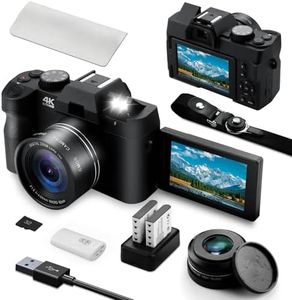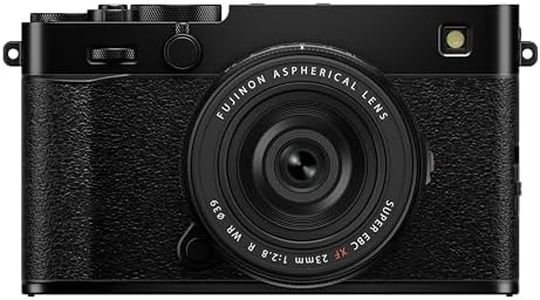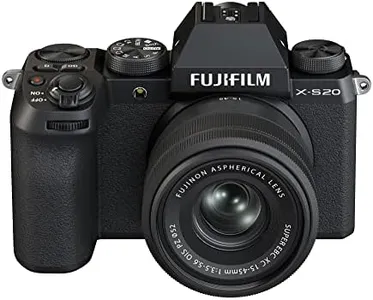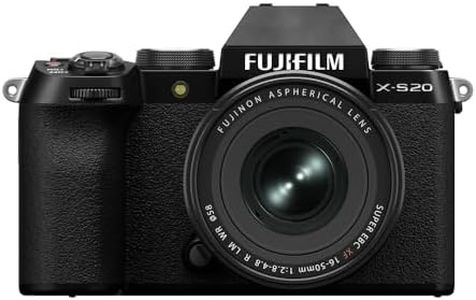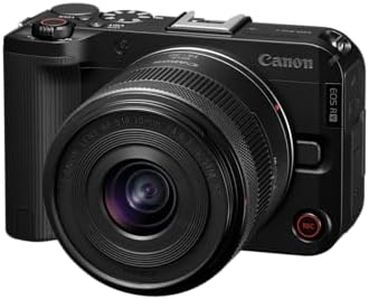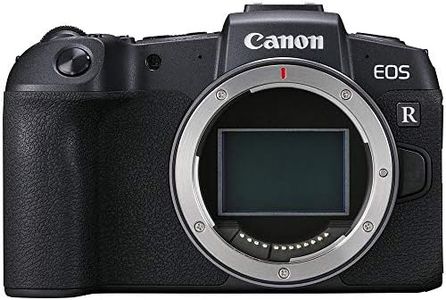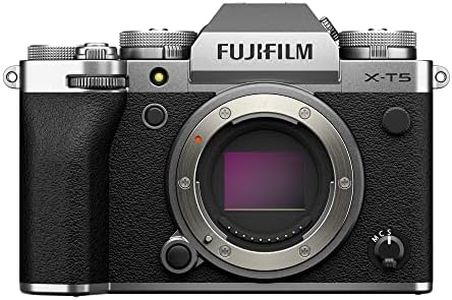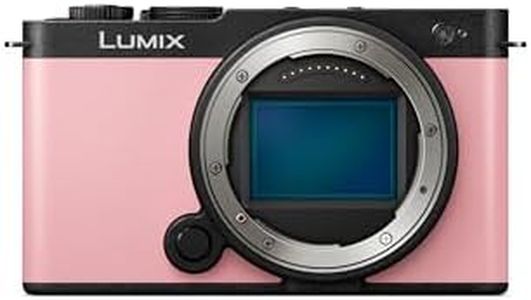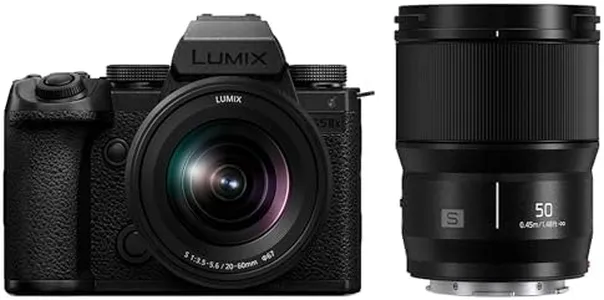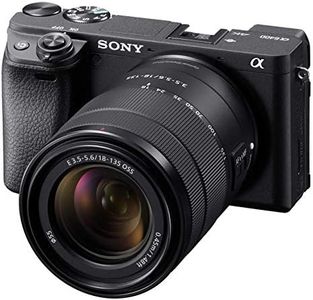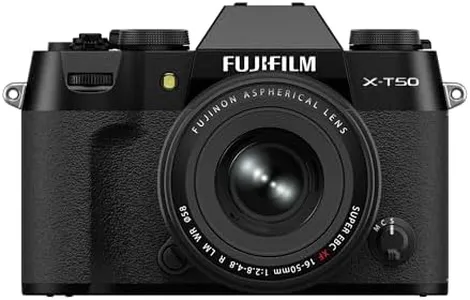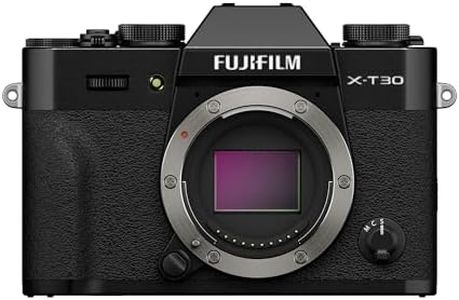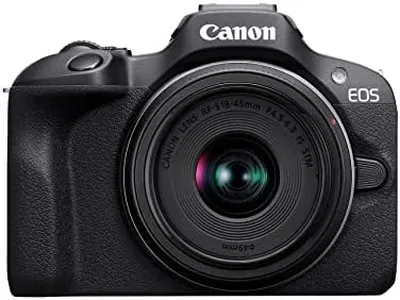10 Best Smallest Mirrorless Camera 2025 in the United States
Our technology thoroughly searches through the online shopping world, reviewing hundreds of sites. We then process and analyze this information, updating in real-time to bring you the latest top-rated products. This way, you always get the best and most current options available.

Our Top Picks
Winner
Sony Alpha ZV-E10 - APS-C Interchangeable Lens Mirrorless Vlog Camera Kit - Black, ZVE10KB
Most important from
848 reviews
The Sony Alpha ZV-E10 is a compact APS-C mirrorless camera designed especially for vloggers and content creators who want high-quality photos and videos in a small package. Its 24.2MP APS-C sensor delivers sharp, detailed images with a bit more depth and light sensitivity than smaller sensors, which is great for both photos and 4K videos. The camera's autofocus system is impressive, with 425 hybrid points including eye and face detection, making it easy to keep subjects in focus even when moving. It also features optical image stabilization to help reduce shake, which is useful for handheld shooting.
The camera comes with a versatile 16-50mm lens suitable for everyday shooting and vlogging. The fully articulating 3-inch LCD screen is bright and can tilt to face forward, perfect for selfies or video blogging. However, it lacks a built-in viewfinder, which some photographers might miss when shooting in bright sunlight. Battery life is moderate, capable of about 125 minutes of video shooting, so carrying a spare might be necessary for extended sessions.
Connectivity is strong with USB, micro HDMI, Wi-Fi, and Bluetooth, allowing easy file transfers and live streaming with a single cable and no extra equipment. The camera is lightweight at just 1.55 pounds, making it very portable for on-the-go use. While the camera isn’t weather-sealed, requiring extra care in harsh conditions, it offers many manual controls for advanced users, although beginners might find some settings overwhelming. Its video features like product showcase focus transitions and background defocus button are user-friendly and enhance creative options. The Sony ZV-E10 is well-suited for vloggers and casual photographers seeking a small, powerful mirrorless camera with excellent autofocus, good image quality, and easy connectivity, but it may not meet the needs of those wanting a viewfinder or rugged durability.
Most important from
848 reviews
FUJIFILM X-E5 Mirrorless Digital Camera XF23mmF2.8 Lens Kit - Black
Most important from
51 reviews
The Fujifilm X-E5 is a compact mirrorless camera that features a high-resolution 40.2-megapixel APS-H sensor, delivering excellent image detail commonly found in larger cameras. Its design and size are similar to Fujifilm's popular fixed-lens models but with the added benefit of interchangeable lenses, supporting over 40 Fujifilm X-mount options, which provides versatility for various shooting styles. The included 23mm f/2.8 lens is lightweight and weather-resistant, ideal for everyday use.
Autofocus performance is fast and reliable, utilizing a hybrid system with 49 focus points and AI-assisted subject detection to enhance capturing moving subjects or shooting in challenging lighting conditions. The in-body image stabilization (IBIS) offers up to seven stops of shake reduction, ensuring sharper handheld shots and smoother videos. The camera also features an intuitive analog control layout with a distinctive film simulation dial, allowing quick access to various color and style presets that replicate classic film looks.
Battery life lasts about 5 hours, which is adequate but may require carrying a spare for extended use. Weighing around 2 pounds and measuring roughly 9 inches in each dimension, it is compact but somewhat heavier than some ultra-small mirrorless models, which may feel bulky for users prioritizing minimal weight. The electronic viewfinder and 3-inch LCD screen provide clear resolution for framing and reviewing images, although the camera lacks a built-in flash. Connectivity options include Bluetooth for easy smartphone pairing. Video recording supports 4K resolution at up to 60fps, making it suitable for casual video work. This camera is well-suited for enthusiasts and photographers seeking a high-quality, compact system with flexible lens options and classic styling, while not being the smallest or lightest model available.
Most important from
51 reviews
Fujifilm X-S20 Mirrorless Digital Camera XC15-45mm Lens Kit
Most important from
119 reviews
The Fujifilm X-S20 Mirrorless Digital Camera stands out in the small mirrorless camera category with its lightweight design, weighing only 491g, making it ideal for on-the-go photography. The 26.1 megapixel sensor and X-Processor 5 ensure high-quality photos and fast performance, while the 180° Vari-Angle LCD touchscreen adds flexibility for creative shots.
It's perfect for both photography and videography, supporting 4K/60P streaming and 6.2K/30p video recording, which is great for vloggers and content creators. The camera's five-axis in-body image stabilization is a significant advantage, reducing camera shake and ensuring sharp images even in low light. The battery life is impressive, offering up to 750 frames per charge in normal mode, so you won't have to worry about frequent recharging.
However, it's worth noting that the camera is not water-resistant, which may limit its use in harsh weather conditions. Additionally, while the autofocus system is advanced with 171 points and subject detection, it's based on contrast detection, which might not be as fast as phase-detection systems in some other cameras. Connectivity is robust with both Wi-Fi and Bluetooth, enhancing ease of sharing and remote control capabilities. Despite these minor drawbacks, the Fujifilm X-S20 is a powerful and versatile choice for those seeking a blend of portability and high performance in a mirrorless camera.
Most important from
119 reviews
Buying Guide for the Best Smallest Mirrorless Camera
When choosing the smallest mirrorless camera, it's important to consider a balance between size, functionality, and image quality. Mirrorless cameras are known for their compact size and versatility, making them a great choice for travel, street photography, and everyday use. To find the best fit for you, focus on key specifications that will impact your photography experience and ensure the camera meets your specific needs.FAQ
Most Popular Categories Right Now
